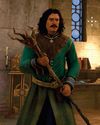يحاول ذهب - حر
HALF-LIGHT
May 2025
|PC Gamer US Edition
A VALVE engineer had to tell the GPU companies they were wrong

The PC gaming icon that is Half-Life 2 turned 20 last November, and Valve pulled out all the stops to celebrate: a major new update, a commentary track and a documentary absolutely crammed with digressions about the challenge the studio set itself. And one of them was lighting. The development of Half-Life 2 was rooted in what multiple staff describe as “the tech wishlist,” which would take six years to fully realize and was absolutely foundational to what Valve wanted to achieve with the game.
“[It] was a main feature that the light felt very, very realistic and intuitive because of the Source engine and the work, the collaboration between artists and engineers,” says Half-Life 2’s lead artist Viktor Antonov, before introducing our hero. “Ken Birdwell, he was a fan about photography and getting the lighting right.”
 Ken Birdwell was one of the earliest hires at Valve (he left the company in 2016) and, like pretty much every Valve employee, wore multiple hats over his time there. But he can fairly be described as an extraordinarily talented computer engineer. Antonov actually undersells the photography angle. Birdwell worked for TeleCalc (a B2B software company) in the 1980s, and clearly saved up enough cash to pursue his passions after leaving: from 1990-94 he studied painting, photography and animation at Evergreen State University and left with a fine arts degree. On Half-Life he primarily worked on the first game’s animations and AI (as well as having the idea for the G-Man). When
Ken Birdwell was one of the earliest hires at Valve (he left the company in 2016) and, like pretty much every Valve employee, wore multiple hats over his time there. But he can fairly be described as an extraordinarily talented computer engineer. Antonov actually undersells the photography angle. Birdwell worked for TeleCalc (a B2B software company) in the 1980s, and clearly saved up enough cash to pursue his passions after leaving: from 1990-94 he studied painting, photography and animation at Evergreen State University and left with a fine arts degree. On Half-Life he primarily worked on the first game’s animations and AI (as well as having the idea for the G-Man). When هذه القصة من طبعة May 2025 من PC Gamer US Edition.
اشترك في Magzter GOLD للوصول إلى آلاف القصص المتميزة المنسقة، وأكثر من 9000 مجلة وصحيفة.
هل أنت مشترك بالفعل؟ تسجيل الدخول
المزيد من القصص من PC Gamer US Edition

PC Gamer US Edition
PREY
One of the most creatively ambitious FPS games of all time.
7 mins
January 2026

PC Gamer US Edition
"Makes me feel more like I'm lost in Holmes' mind palace"
Felt delightfully cosy and smug while playing SHERLOCK HOLMES: THE AWAKENED
2 mins
January 2026

PC Gamer US Edition
"I'm dripping with gore"
SILENT HILL F is, so far, a violent treat
1 mins
January 2026

PC Gamer US Edition
RELOOTED
Robbing the robbed back from those who robbed it
2 mins
January 2026

PC Gamer US Edition
UP TO SCRATCH
SCRATCH AND REVEAL challenges perceptions of gender
1 min
January 2026

PC Gamer US Edition
PEAK
Climbing with your friends just got more stressful.
3 mins
January 2026

PC Gamer US Edition
SCHOOL DAZE
Revisiting the school of hard knocks in BULLY
2 mins
January 2026

PC Gamer US Edition
GET STARTED IN BATTLEFIELD 6
Load up on guns and bring your friends.
2 mins
January 2026

PC Gamer US Edition
THE ETHICS OF EATING FLESH, A QUEASY QUEST IN DREAD DELUSION
Plenty of RPGs bang on about choice and consequence—this delivers.
3 mins
January 2026

PC Gamer US Edition
THE ART OF ILLUSION IN THE ELDER SCROLLS IV: OBLIVION REMASTERED
You just can't get the staff: Crispin the Preposterous's grand finale
7 mins
January 2026
Listen
Translate
Change font size
